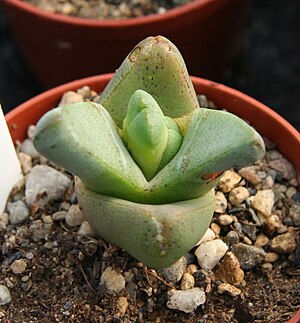Tanquana
| Tanquana | ||||||||||||
|---|---|---|---|---|---|---|---|---|---|---|---|---|

Tanquana prismatica |
||||||||||||
| Systematics | ||||||||||||
|
||||||||||||
| Scientific name | ||||||||||||
| Tanquana | ||||||||||||
| HEKHartmann & Liede |
Tanquana is a genus of plants fromthe afternoon flower family (Aizoaceae). The botanical name refers to the Tanqua- Karoo , the main distribution area of the plants.
description
The plants of the genus Tanquana grow compact and can be sunk into the ground. They cannot be branched ( Tanquana hilmarii ) or branched and survive during the resting phase with a single pair of leaves. The thick leaves of a pair of leaves are uneven and end in rounded tips. They have a smooth, bright green to purple surface. Due to the idioblasts located below the crystal-free outer epidermis wall , which are plant cells that differ significantly in shape from the surrounding cells, the leaves look spotted.
The flower stands individually above the bracts . The calyx is four to five lobed. Your 30 to 70 petals are colored yellow. The stamens are papillary at the base . In their homeland, the flowering period extends from around April to May. The strongly fragrant flowers open in the afternoon and close again in the evening.
The light brown fruits , funnel-shaped at the base, reach a diameter of up to 10 millimeters and are similar to those of the genus Titanopsis . The nine to ten compartment capsules have tiny endocarpic closing bodies . The light brown seeds are less than 1 millimeter long. Their outer seed coat (testa) has slightly raised cells.
Systematics and distribution
The distribution area of the genus Tanquana is in the central part of the South African province of Western Cape . It extends over the Tanqua- Karoo and Great Karoo to the south of the Little Karoo near Laingsburg . The plants grow on Dwyka - and Ecca - shale near the southeastern border of the winter rainfall region with an annual rainfall of less than 200 millimeters.
The first description was made in 1986 by Heidrun Hartmann (* 1942) and Sigrid Liede (* 1957). The type species is Tanquana archeri . According to Hartmann (2001), the genus includes the following species:
- Tanquana archeri (L.Bolus) HEKHartmann & Liede
- Tanquana hilmarii (L.Bolus) HEKHartmann & Liede
- Tanquana prismatica (Schwantes) HEK Hartmann & Liede
The genus Tanquana is often still regarded as part of the genus Pleiospilos . They differ from the genus Pleiospilos by the non-keeled leaves and the much smaller, convex seed capsules only have tiny closing bodies.
Tanquana hilmarii can easily be taken for a species of the genus Lithops and was initially associated with this genus by its discoverer Hilmar Lückhoff.
proof
literature
- PS Green, Klaus Kubitzki, E. Götz, KU Kramer: The Families and Genera of Vascular Plants . Volume 1, p. 59, Springer, 1990, ISBN 3540555099
- Heidrun EK Hartmann: Illustrated Handbook of Succulent Plants: Aizoaceae AZ , Springer Verlag, Berlin / Heidelberg / New York 2001, p. 315, ISBN 3-540-41691-9
- Gideon Smith et al. a .: Mesembs of the World: Illustrated Guide to a Remarkable Succulent Group . Briza Publications 1998, pp. 128-129. ISBN 1-875093-13-3
Individual evidence
- ↑ HEK Hartmann, S. Liede: The genus Pleiospilos s. Latin (Mesembryanthemaceae) In: Botanical yearbooks for systematics, plant history and plant geography . Volume 106, No. 4, p. 479, Leipzig 1986
- Jump up ↑ Heidrun EK Hartmann: Illustrated Handbook of Succulent Plants: Aizoaceae AZ , Springer Verlag, Berlin / Heidelberg / New York 2001, p. 315